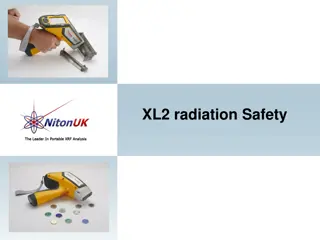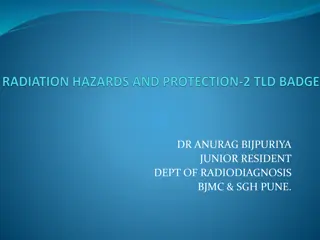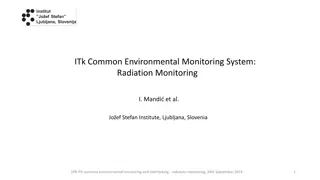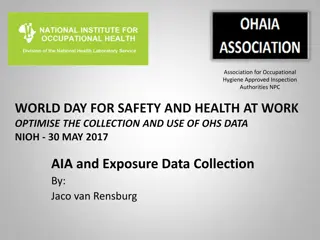Understanding Radiation Dosimeters for Occupational Exposure Monitoring
Radiation dosimeters, like Thermoluminescent Dosimeters (TLD), are vital tools for measuring occupational exposure to ionizing radiation. TLDs work by storing energy from radiation exposure in crystals, which is later released as light when heated for measurement. Dosimeters are assigned to specific body areas such as the ring, collar, and whole body for effective monitoring. Dosimeters must be handled carefully and any accidental exposures should be reported promptly to ensure proper safety protocols are followed.
Download Presentation

Please find below an Image/Link to download the presentation.
The content on the website is provided AS IS for your information and personal use only. It may not be sold, licensed, or shared on other websites without obtaining consent from the author. Download presentation by click this link. If you encounter any issues during the download, it is possible that the publisher has removed the file from their server.
E N D
Presentation Transcript
Radiation Dosimeters are used to measure Occupational exposure to Ionizing Radiation The most common type of Radiation Dosimeter is the Thermo Luminescent Dosimeter ( TLD)
How does a TLD work? When exposed to ionizing radiation the crystals in Thermoluminescent dosimeters or TLD s undergo a structural change that remains essentially stable until the crystal is heated. When heated, the stored energy is released as light, which can be measured and related to the level of radiation exposure. One crystal measures deep dose and one measures shallow dose.
Radiation Dosimeters are assigned to be worn on specific areas of the body. There are 3 different types of dosimeters worn at LHSC Ring Collar Whole body
Whole Body Badge Location Body badges measures dose to the main body trunk . It should be worn on the clothing between the waist and chest. When wearing a lead apron it should be worn close to the skin under the lead protection.
Collar Badge Location Collar badges measures the dose to the head . It is worn outside the thyroid collar during fluoroscopic procedures. It measures the unshielded dose to the head.
Ring Badge Location Your Ring Badge will come with your name on it. Wear the badge with the name plate facing the source of radiation.
Handling of Dosimeters Dosimeters must be handled carefully. They can not be exposed to Water Heat Punctured damaged
Accidental Exposures Any accidental exposure to the TLD monitoring badge/ring should be reported immediately to the to the Radiation Safety Officer.
Damaged or Lost Badge If you lose or damage your TLD monitoring badge/ring please report it immediately to the Radiation Safety Officer. You will be then given a replacement
Dose Reports Include: Dose readings by Badge Type Collar Whole body Ring Cumulative Dose History Current Quarter Year to date Lifetime to date All Dose Reports are reviewed by the Radiation Safety Officer
Occupational Dose Limits for Radiation Workers Source of Radiation Whole Body Dose should not to exceed 20 mSv/ yr
Occupational Dose to the Lens of the Eye Dose should not exceed 150 mSv / yr
Occupational Exposure Limit to the Extremities The Dose Limit to the Extremities should not exceed 150 mSv / yr
Occupational Dose Limit for Declared Pregnant Mothers Dose should not exceed 4 mSv during the gestation period for declared pregnant mothers.
Annual Dose Limit to a General Member of the Population X-ray room Should not exceed 1 mSv/yr
Points to Remember -Whole Body badges to be worn under lead aprons -Collar badge to be worn outside lead -If you lose/damage or accidentally expose badge Please contact RSO/ supervisor _ Do not expose your badge to water, heat























